+7 (812) 929-8283
Cisco Aironet 1400
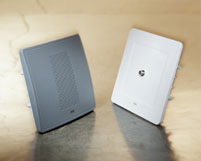
Беспроводной мост Cisco Aironet серии 1400, работающий на частоте 5ГГц по стандарту 802.11а, является высокопроизводительным и многофункциональным решением для объединения различных локальных сетей в рамках единой сети уровня MAN.
Беспроводные мосты Cisco Aironet серии 1400 Wireless представляют собой превосходное решение для организации высокоскоростных, высокопроизводительных мостовых соединений между точками, расположенными вне зданий в пределах прямой видимости. Эти мосты поддерживают следующую функциональность:
- Конфигурации "точка-точка" и "точка-множество точек"
- Лучшие в отрасли показатели дальности действия и пропускной способности (совокупная пропускная способность достигает 54 Мбит/с)
- Мощные механизмы безопасности, основанные на стандартах 802.11
- Корпус повышенной защищенности, который оптимизирован для работы в довольно суровых условиях на открытом воздухе, характеризующихся большими перепадами температур
- Наличие моделей со встроенными антеннами или моделей с разъемами (в этом случае необходимо будет приобрести антенну(ы) отдельно) для подключения внешних антенн обеспечивает необходимую гибкость при внедрении
- Обеспечивают максимальное удобство при установке и эксплуатации
Общая архитектура построения беспроводных сетей Cisco Unified Wireless Network
Архитектура Cisco Unified Wireless Network обладает превосходными характеристиками в области безопасности, управляемости, функциональности и радио-частотной эффективности для предоставления беспроводного доступа к корпоративным приложениям.
Безопасность беспроводных сетей
Безопасность беспроводных сетей может быть обеспечена на очень высоком уровне. Узнайте больше о том, как это сделать стандартными средствами, а также о продуктах Cisco, позволяющих перейти на новый уровень контроля и защиты корпоративной беспроводной сети.
Cisco Aironet 1400 Series Wireless Bridge
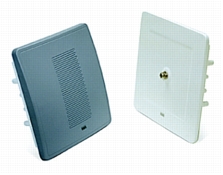
OVERVIEW
The Cisco Aironet® 1400 Series Wireless Bridge creates a new benchmark for wireless bridging by providing a high-performance and feature-rich solution for connecting multiple LANs in a metro area. Building a metropolitan area wireless infrastructure with the Cisco Aironet 1400 Series Wireless Bridge provides deployment personnel with a flexible, easy to use solution that meets the security requirements of wide area networking professionals. Designed to be a cost-effective alternative to leased lines, it is engineered specifically for harsh outdoor environments, yet also works well in indoor deployments. The Cisco Aironet 1400 Series Wireless Bridge is the premier high-speed, high-performance outdoor bridging solution for line-of-sight applications, providing features such as:
- Support for both point-to-point or point-to-multipoint configurations (Figure 1)
- Industry leading range and throughput, supporting data rates up to 54 Mbps
- Enhanced security mechanisms based on 802.11 and 802.11i standards
- Ruggedized enclosure optimized for harsh outdoor environments with extended operating temperature range
- Integrated or optional external antennas for flexibility in deployment
- Designed specifically for ease-of-installation and operation
BRIDGING FIXED NETWORKS
The Cisco Aironet 1400 Series Wireless Bridge can be used to provide either:
- The sole connection
- The primary connection with an additional technology such as a T1 line providing redundancy, or
- As a back up solution for additional resiliency in conjunction with other technologies such as fiber optics.
Ideal applications include:
- Local Government-Backbone (backhaul) portion of community-based municipal networks such as public safety networks, or any fixed network location
- Education-Higher education campus building interconnects and K-12 schools within a metropolitan area
- Healthcare-Hospital campuses and physician offices
- Enterprise Campus-Building-to-building links (point-to-point or point-to-multipoint), or any situation where a company needs to expand across an area where right-of-way is not possible
- Service Provider-Backhaul to aggregate multiple lower-speed links into a higher speed link
Figure 1. Point-to-Point and Point-to-Multipoint Applications
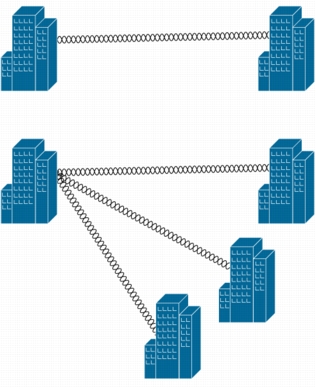
Mobile Networks and Wireless Bridges
The concept of mobile networks is significant not only for service providers looking to offer seamless network access, but also for individual organizations such as municipal public safety units. In many instances, the technology exists to create the zones that provide the mobile network, but the challenge lies in bringing the network to these zones. The Cisco Aironet 1400 Series Wireless Bridge provides a cost-effective solution to this application. The wireless bridge can connect to the network that contains the 2.4 GHz access points or bridges that are providing wireless zone coverage, and also provide the backhaul link to the high-speed network (Figure 2). Whether these zones are 802.11 hot spots at cafes and restaurants or bridged 802.11b cells for mobile networks, the Cisco Aironet 1400 Series Wireless Bridge provides a non-interfering and higher speed distribution service.
Figure 2. Public Safety Network Utilizing Wireless Bridges
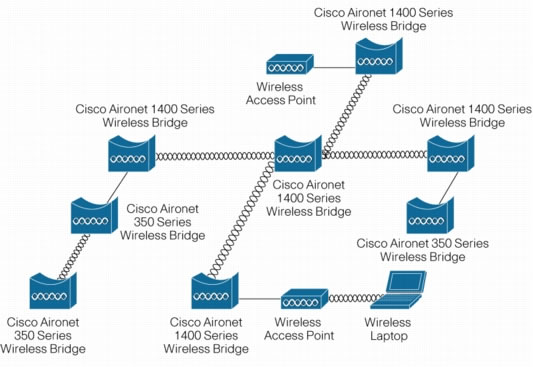
ROI
The high-speed links between the wireless bridges deliver throughput several times faster than E1/T1 lines for a fraction of the cost-eliminating the need for expensive leased lines or difficult-to-install fiber-optic cable. Because bridges have no recurring charges, savings on leased-line services quickly pay for the initial hardware investment. The Cisco Aironet 1400 Series with its 54 Mbps throughput capability connects discrete sites into a single LAN at speeds much greater than leased lines, even when they are separated by obstacles such as freeways, railroads, or bodies of water that are practically insurmountable using copper or fiber-optic cable.
High Performance
Operating in the unlicensed 5.8 GHz band, the Cisco Aironet 1400 Series Wireless Bridge sets a new standard for performance, combining powerful 250 mW radios, industry-leading receive sensitivity, installation tools to assist in bridge placement, delay spread capabilities, and a choice of integrated or connectorized high gain antennas, Cisco provides a complete solution for a wide variety of fixed wireless applications.
Data rates of 54 Mbps can be enabled for point-to-point links up to 8.5 miles, and for point-to-multipoint links up to 2.75 miles. Aggregate throughput can be obtained in excess of 28 Mbps. Also, by using higher gain antennas or lower data rates, ranges in excess of 20 miles point-to-point can be covered.1
Security
Cisco Aironet has a proven track record for leading the industry with advanced security features. Building on basic wireless security, support for the Cisco Wireless Security Suite is included with the Cisco Aironet 1400 Series Wireless Bridge (Figure 3), featuring support for IEEE 802.1X mutual authentication and strong encryption with Temporal Key Integrity Protocol (TKIP). Network managers can confidently deploy a wireless bridging solution that provides robust security and protection, with the ease of centralized management through a Remote Authentication Dial-In User Service (RADIUS) server such as Cisco Secure Access Control Server (ACS).
Figure 3. Wireless Bridge Security with the Cisco Wireless Security Suite
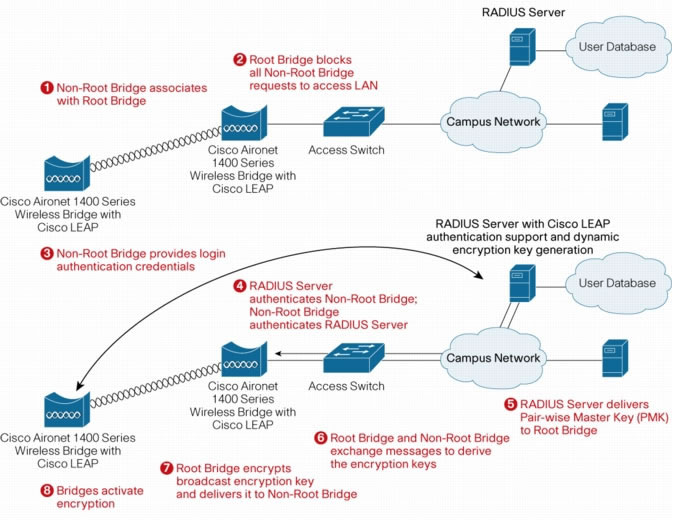
Intelligent Network Services
The Cisco Aironet 1400 Series Wireless Bridge utilizes Cisco IOS® Software to provide a familiar user interface with common functionality, scalability, and security. Additionally, advanced features such as quality of service (QoS) are included, enabling packet prioritization for voice, video, and data. Trunking up to 24 voice-over-IP (VoIP) circuits and data over point-to-point links is also possible. Bandwidth can be increased between bridged networks through the aggregation of multiple bridges at each site through Fast Ether Channel (FEC), or Port Aggregation Protocol (PAg-P), or through routing protocols. For a multipurpose network, Virtual Local Area Networks (VLANs) can be configured by allowing different non-root bridges operating on the same root bridge to trunk different VLANS. Network services can now be segmented based upon end user requirements (Figure 4).
Figure 4. VLAN Configuration for Wireless Bridges
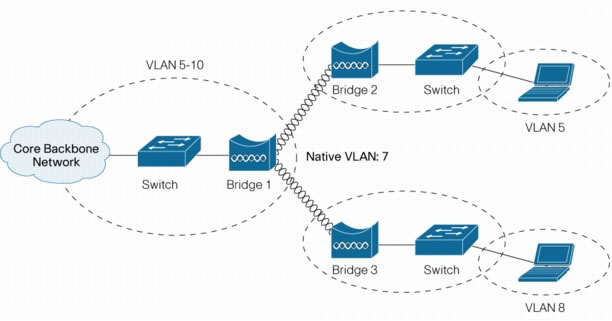
Flexible
Rapid deployment and redeployment can be achieved with no reliance upon telecommunications providers nor a lengthy license or trenching process. The Cisco Aironet 1400 Series Wireless Bridge allows placement in an outdoor environment without the use of an expensive additional National Electrical Manufacturers Association (NEMA) enclosure. Further flexibility is achieved by enabling point-to-point or point-to-multipoint networks with a single product line. The mounting bracket has been designed to allow installation on poles, walls, and roofs, while also providing a mechanism for choosing the desired polarization. The Cisco Aironet 1400 Series Wireless Bridge offers an outdoor wireless bridging solution in two product SKUs. The captured antenna version features an integrated radio and high-gain integrated antenna for user installations of point-to-point links and the non-root nodes of point-to-multipoint networks. The connectorized version provides professional installers with an N-Type connector that allows the deployment of the root nodes of point-to-multipoint networks with omni-directional or sector antennas, or of high gain dish antennas for longer links. The external antenna options are:
- 9.0 dBi vertically polarized omni antenna
- 9.5 dBi sector antenna with support for vertical or horizontal linear polarization
- 28.0 dBi dish antenna with support for vertical or horizontal linear polarization
Ease of Use
Based upon IEEE 802.11a technology and utilizing the same Cisco IOS Software as in a wired network, the Cisco Aironet 1400 Series provides a user with a familiar experience that supports an "out-of-the-box" deployment. Convenient LEDs and an externally accessible Received Signal Strength Indicator (RSSI) for alignment feedback/diagnostics and a quick-hang mounting bracket allows for an easy installation process.
To simplify ordering and installation, the Cisco Aironet 1400 Series Wireless Bridge provides the professional or IT installer with all of the components and accessories necessary to complete most deployments, including:
- The Cisco Aironet Power Injector LR for supplying power to the bridge without expensive electrician costs (Figure 5). The power injector also extends the distance the 1400 Series Wireless Bridge can be installed from the network. (Figure 6)
- The Cisco Aironet 1400 Series Multifunction Mount, with its innovative design, to provide greater ease of installation and flexibility. The mount comes complete with stainless steel hardware to improve corrosion resistance.
- Two lengths of shielded Dual RG-6 cables and a building entry point grounding block, all with F-Type connectors for use with the Power Injector LR and connection to the bridge unit.
- A power supply and cord, enough coaxial sealant for all outdoor connectors, and corrosion-proof gel to protect grounding connections.
Figure 5. Cisco Aironet Power Injector
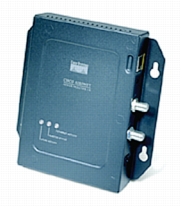
Figure 6. Power Injector Distance Extension
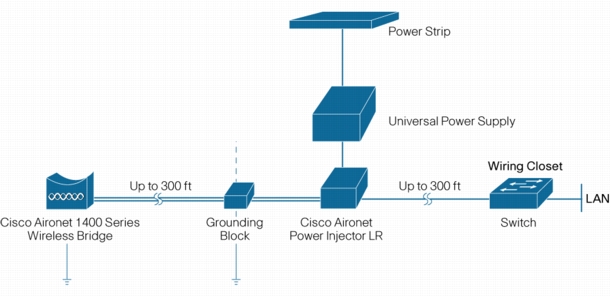
Advanced Management Features
The CiscoWorks Wireless LAN Solution Engine (WLSE) is available as a management tool for Cisco Aironet access points operating autonomously (without a Wireless LAN Controller) and wireless bridges. CiscoWorks WLSE is a turnkey, scalable, and centralized management platform with an HTML-based interface. It uses Simple Network Management Protocol (SNMP) and Secure Shell (SSH)/Secure Sockets Layer (SSL) for managing Cisco Aironet access points and wireless bridges via a Web browser.
For more information on CiscoWorks WLSE, visit: http://www.cisco.com/go/wlse
See Table 1 for additional features and benefits. For system specifications of the Cisco Aironet 1400 Series Wireless Bridge see Table 2, for product specifications see Table 3.
Table 1. Features and Benefits
| Features | Benefits |
|---|---|
| 802.11a radio with 24 dBm (250 mW) maximum transmit power, -70 dBm receive sensitivity at 54 Mbps data rate1 | The 5.8 GHz radio in the Cisco Aironet 1400 Series offers superior radio performance that results in industry-leading range. The greater the range, the higher the supported data rate or the more reliable the link at a given data rate. |
| Industry-leading security, network management, and software feature set | The Cisco Aironet 1400 Series software builds on the feature-rich, customer-driven Cisco Aironet software and the Cisco Wireless Security Suite, including 802.1X support with mutual authentication and dynamic encryption keys with TKIP; management through SNMP, Telnet, and Web browsers. |
| Fully weatherized metal housing and extended operating temperature (-30º to +55ºC) | The rugged weatherproof design of the Cisco Aironet 1400 Series provides flexibility for deployment in a variety of settings. The rugged features and broad operating temperature range support deployment in factories, warehouses, and the outdoors. |
| The Cisco Aironet Power Injector LR | The Power Injector LR converts the standard 10/100 baseT Ethernet category 5 RJ-45 interface that is suitable for weather-protected areas to a dual F-Type connector interface for dual coax cables that are more suitable for harsh outdoor environments. While providing a 100baseT interface to the Cisco Aironet 1400 Series, the Power Injector LR also provides power to the unit over the same cables with a power discovery feature that protects other appliances from damage should they accidentally be connected. As an added benefit to the installer, Auto MDIX is built in, allowing the dual cables to be swapped and while maintaining the same functionality. To support longer cable runs from your infrastructure network switch or router, the Power Injector LR is designed to accommodate 100 m coaxial cable run plus 100 m of indoor cat5 cable, to enable total cable runs up to 200 meters. Lightning and surge protection is also included at the F-Type connector interface to provide added protection to your network infrastructure devices. |
| Flexible mounting with multifunction mount or optional roof/wall mount | The Cisco Aironet 1400 Series Multifunction Mount allows the captured antenna Cisco Aironet 1400 Series to provide either horizontal or vertical polarization. With its quick-hang feature, the mount will support the weight of the bridge during the alignment process. To assist the installation, hoisting rings are attached to the mount. The mount will interface to poles or masts from 1.5 in. to 2.5 in. while allowing for elevation and azimuth alignment. For the connectorized version, the mount provides a wall mount mechanism. The captured antenna Cisco Aironet 1400 Series can be mounted to a wall, roof, or other flat surface with the addition of the optional Cisco Aironet 1400 Series Roof/Wall Mount kit. |
| Wireless root bridge | The wireless root bridge role provides the Cisco Aironet 1400 Series with support for both point-to-point or point-to-multipoint bridging |
| Wireless non-root bridge | The wireless non-root bridge allows the Cisco Aironet 1400 Series to operate as the remote node in a point-to-point or point-to-multipoint bridge network. |
| Wireless packet concatenation | The concatenation of smaller packets into larger ones allows the Cisco Aironet 1400 Series to more efficiently utilize the wireless medium and provide higher overall data throughputs. |
| Wireless link distance adjustment | The link distance parameter allows the user to tune the carrier sense multiple access with collision avoidance (CSMA/CA) parameters for the particular range to maximize performance. |
| Wireless programmable clear channel assessment | With a programmable clear channel assessment, the Cisco Aironet 1400 Series can be configured to the particular background interference level found in your environment for reduced contention overhead with other wireless systems. |
| Antenna alignment assistance | The Cisco Aironet 1400 Series Wireless Bridge provides an auto-configuration and installation mode for out of the box deployment of point to point links without the need for a configuration via telnet, File Transfer Protocol (FTP), or SNMP. This mode drives LEDs and a Received Signal Strength Indicator (RSSI) port with a voltage output proportional to received signal strength for use in the installation and alignment process. This frees up the installers to perform their installation process and verify the link quality without requiring Cisco IOS Software or data networking knowledge. |
| Diagnostic LEDs | Provide alignment feedback to the installer and diagnostic information to troubleshooters directly at the antenna without the use of a computer. Diagnostic information is also provided on the Power Injector LR LEDs |
| 16 megabytes of flash memory | Memory space for future firmware upgrades to support new 802.11 standards and advanced features. |
| One N-Type connector for external antenna connection | The N-Type connector is the industry standard for higher performance RF systems in an outdoor environment and is compatible with the Cisco® line of optional 5.8 GHz antennas, enabling wireless bridging professional installers to customize radio coverage for specific deployment scenarios. |
| Easy weather sealing and grounding | The Cisco Aironet 1400 Series provides standard N-Type and F-Type coaxial cable connectors for easy and reliable weather sealing and grounding. A coaxial sealant is provided with each system, along with a standard grounding block to allow the installer to meet National Electric Code guidelines. |
124 dBm transmit power only available in FCC configuration units
Table 2. Cisco Aironet 1400 Series Wireless Bridge System Specifications
| AIR-BR1410A-x-K9 | AIR-BR1410A-A-K9-N | |
|---|---|---|
| Frequency band | 5.725 to 5.825 GHz (FCC UNII 3) | 5.725 to 5.825 GHz (FCC UNII 3) |
| Wireless modulation | Coded Orthogonal Frequency Division Multiplexing (COFDm | Coded Orthogonal Frequency Division Multiplexing (COFDm |
| Media access protocol | Carrier Sense Multiple Access with Collision Avoidance (CSMA/CA) | Carrier Sense Multiple Access with Collision Avoidance (CSMA/CA) |
| Modulation | ||
| Non-overlapping channels | 4 | 4 |
| Receive sensitivity (10% PER with 3200 byte packets) | ||
| Maximum operational receive level | -19 dBm | -19 dBm |
| Maximum survivable receive level | 0 dBm | 0 dBm |
| Available transmit power settings | ||
| Note: Maximum power setting will vary according to individual country regulations | ||
| Point-to-point range1 | ||
| Point-to-multipoint range (sector antenna at root)3 | ||
| Antenna | Captured Linear Polarization; 22.5 dBi gain2: 10° E-plane by 12° H-plane beamwidth | One N-Type connector for professional installations (antennas sold separately) |
| Security | Cisco Wireless Security Suite, including: |
Cisco Wireless Security Suite, including: |
| SNMP compliance | v1 and v2 | v1 and v2 |
1The distances referenced here are approximations and should be used for estimation purposes only.2AIR-BR1410A-K-K9 has 20 dBi gain
Table 3. Cisco Aironet 1400 Series Wireless Bridge Product Specifications
| AIR-BR1410A-x-K9 | AIR-BR1410A-A-K9-N | Power Injector LR | |
|---|---|---|---|
| Status LEDs | Four LEDs: |
Four LEDs: |
Four LEDs: |
| RSSI port | BNC connector DC Voltage port (0VDC to 2.7 VDC) | BNC connector DC Voltage port (0VDC to 2.7 VDC) | - |
| Uplink | 100 Mbps over dual coaxial cables | 100 Mbps over dual coaxial cables | 10/100BaseT Ethernet |
| Configuration support | Telnet, HTTP, FTP, TFTP, SNMP | Telnet, HTTP, FTP, TFTP, SNMP | - |
| Country compliance | Customers are responsible for verifying approval for use in their country. Please see http://www.cisco.com/go/aironet/compliance to verify approval and to identify the regulatory domain that corresponds to a particular country. Not all regulatory domains have been approved. As they are approved, the part numbers will be available on the Global Price List. | ||
| Dimensions | 29cm x 29cm x 11cm | 29cm x 29cm x 9cm | 17cm x 16cm x 3cm |
| Weight | 5 kg | 5 kg | 0.6kg |
| Operational temperature | -30º to +55ºC | -30º to +55ºC | 0º to +50ºC |
| Storage temperature | -40º to +85ºC | -40º to +85ºC | -40º to +70ºC |
| Operational altitude | 4206 m | 4206 m | 4206 m |
| Storage altitude | 4877 m | 4877 m | 4877 m |
| Humidity | 0 to 100% (condensing) | 0 to 100% (condensing) | 0 to 90% (non-condensing) |
| Vibration | 0.001 G2/Hz from 5-100 Hz | 0.001 G2/Hz from 5-100 Hz | 0.001 G2/Hz from 5-100 Hz |
| Storage vibration | 0.01 G2/Hz from 5-100 Hz | 0.01 G2/Hz from 5-100 Hz | 0.01 G2/Hz from 5-100 Hz |
| Enclosure | Aluminum with environmentally sealed plastic radome | NEMA-4, aluminum | Metal case |
| AC power | Not Required as uses DC voltage from Power Injector | Not Required as uses DC voltage from Power Injector | 100 to 240 VAC+/- 10% (power supply) |
| DC power | 48 VDC +/-2V | 48 VDC +/-2V | 48 VDC +/-2V |
| Warranty | One year | One year | One year |
1Aggregate throughput can be obtained in excess of 28 Mbps. Also, by using higher gain antennas or lower data rates, ranges in excess of 20 miles point-to-point can be covered.

